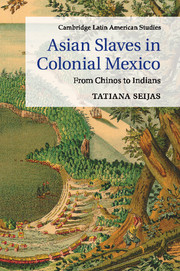Crossref Citations
This Book has been
cited by the following publications. This list is generated based on data provided by Crossref.
Behrend-Martínez, Edward
2015.
Spain violated: foreign men in Spain's heartland.
European Review of History: Revue européenne d'histoire,
Vol. 22,
Issue. 4,
p.
579.
Chakravarti, Ananya
2015.
Peripheral eyes: Brazilians and India, 1947–61.
Journal of Global History,
Vol. 10,
Issue. 1,
p.
122.
van Deusen, Nancy E.
2015.
Indios on the move in the sixteenth-century Iberian world.
Journal of Global History,
Vol. 10,
Issue. 3,
p.
387.
2015.
Global Indios.
p.
289.
2015.
Books Received.
Journal of Latin American Studies,
Vol. 47,
Issue. 2,
p.
455.
Carrillo, Ruben
2015.
Mexique : la china poblana ou la construction d’un mythe national.
Raison présente,
Vol. N° 193,
Issue. 1,
p.
33.
Marcocci, Giuseppe
2016.
Blackness and Heathenism. Color, Theology, and Race in the Portuguese World, c. 1450-1600.
Anuario Colombiano de Historia Social y de la Cultura,
Vol. 43,
Issue. 2,
p.
33.
Seijas, Tatiana
2016.
Asian migrations to Latin America in the Pacific World, 16th–19th centuries.
History Compass,
Vol. 14,
Issue. 12,
p.
573.
Goetz, Rebecca Anne
2016.
Indian Slavery: An Atlantic and Hemispheric Problem.
History Compass,
Vol. 14,
Issue. 2,
p.
59.
Leibsohn, Dana
and
Priyadarshini, Meha
2016.
Transpacific: beyond silk and silver.
Colonial Latin American Review,
Vol. 25,
Issue. 1,
p.
1.
Mawson, Stephanie
2016.
PhilippineIndiosin the Service of Empire: Indigenous Soldiers and Contingent Loyalty, 1600–1700.
Ethnohistory,
Vol. 63,
Issue. 2,
p.
381.
Reséndez, Andrés
2017.
An Early Abolitionist Crusade.
Ethnohistory,
Vol. 64,
Issue. 1,
p.
19.
Cave, Scott
2017.
Madalena:The Entangled History of One Indigenous Floridian Woman in the Atlantic World.
The Americas,
Vol. 74,
Issue. 2,
p.
171.
Bialuschewski, Arne
and
Fisher, Linford D.
2017.
Guest Editor’s Introduction: New Directions in the History of Native American Slavery Studies.
Ethnohistory,
Vol. 64,
Issue. 1,
p.
1.
Hernández, María Luisa Ortega
2017.
Vox populi, vox Dei: Catalina de San Juan, ‘la Niña Santa’ de la Angelópolis (India, 1605? – Puebla de los Ángeles, México, 1688).
Colonial Latin American Review,
Vol. 26,
Issue. 2,
p.
219.
2017.
The Lords of Tetzcoco.
p.
197.
Bauer, Ralph
and
Norton, Marcy
2017.
Introduction: entangled trajectories: indigenous and European histories.
Colonial Latin American Review,
Vol. 26,
Issue. 1,
p.
1.
2017.
Lepanto als Ereignis.
p.
73.
2017.
Liberalism as Utopia.
p.
244.
Peyrol-Kleiber, Elodie
Aje, Lawrence
and
Faucquez, Anne-Claire
2018.
Introduction.
Mémoire(s), identité(s), marginalité(s) dans le monde occidental contemporain,



